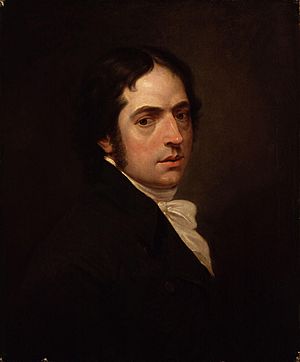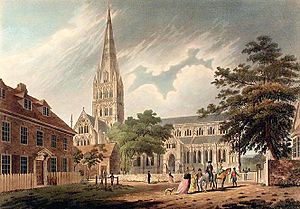Edward Dayes facts for kids
Edward Dayes (born in London in 1763 – died in London in May 1804) was a talented English artist. He was known for his beautiful watercolour paintings and for making a special kind of print called a mezzotint.
About Edward Dayes
Edward Dayes learned art from William Pether. He started showing his artwork at the Royal Academy in 1786. His first show included a portrait and scenes from places like Waltham Cross and Canterbury.
For the next few years, he showed both tiny paintings (miniatures) and larger landscape pictures. He continued to display his art at the Royal Academy until he passed away. In total, he showed 64 pieces there. He also exhibited his work at the Society of Artists.
His Art Style
Dayes loved to draw scenes from nature across England. He visited places like the Lake District and Wales. Many of his landscape paintings showed old ruins. He often used shades of blue and green in his art.
His style influenced famous artists like J. M. W. Turner when Turner was just starting out. Dayes even wrote a book called Instructions for Drawing and Colouring Landscapes. It gave detailed tips on how to use colours in landscape painting. This book was published after he died.
Art expert Graham Reynolds said that Dayes' work helped connect the art styles of the 1700s and 1800s.
Famous Works
Many of Dayes' drawings were full of people. Some of his well-known works include two views of the inside of St. Paul's Cathedral. These showed the celebration for the king's recovery in 1789.
He also painted The Trial of Warren Hastings in Westminster Abbey. Another famous piece was Buckingham House, St. James's Park from 1780. This painting was later displayed in the South Kensington Museum. Many of these detailed works were later turned into engravings.
Later in his career, around 1798, Dayes started painting scenes from the Bible. Examples include The Fall of the Angels (1798) and John preaching in the Wilderness (1799). He also created The Triumph of Beauty (1800) and Elisha causing Iron to swim (1801).
Students and Writings
Edward Dayes was the official artist for the Duke of York and Albany. He also taught art to other students. One of his most famous students was Thomas Girtin, who became a well-known watercolour artist himself.
Besides painting, Dayes also made engravings. He created at least four mezzotints. He also wrote several books. These included An Excursion through Derbyshire and Yorkshire, Essays on Painting, and Professional Sketches of Modern Artists. After he died, his writings were put together and published in 1805. This was done to help his wife.
His wife was also an artist. She painted miniatures and showed four of her works at the Royal Academy between 1797 and 1800.
Sources
 This article incorporates text from a publication now in the public domain: "Dayes, Edward". Dictionary of National Biography 14. (1888). Ed. Leslie Stephen. London: Smith, Elder & Co.
This article incorporates text from a publication now in the public domain: "Dayes, Edward". Dictionary of National Biography 14. (1888). Ed. Leslie Stephen. London: Smith, Elder & Co.



